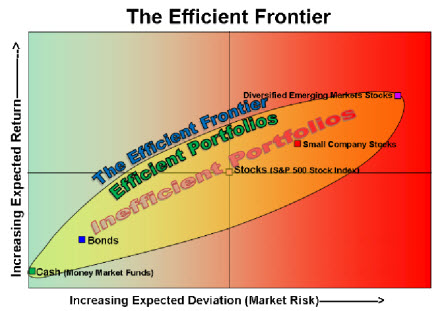Horowitz & Company‘s Global Allocation Strategies employ multiple tactics providing flexibility and customization for client portfolios. The goal of this discussion is to provide a better understanding of how we attempt to mitigate risk while sharing some of our key investment philosophies and theories.
The basic tenets of Modern Portfolio Theory (MPT) suggests diversifying amongst historically uncorrelated asset classes with proper rebalancing techniques can optimize your return based on one‘s individual tolerance of risk. However, as we have seen in recent years, a diverse mix between equities and fixed income has failed to adequately protect downside risk. While diversification helped to provide lower volatility, as compared to an equity-only portfolio, it did not mitigate it entirely. Since markets are thought to be efficient, market timing for long-term investment horizons may not be suitable.
The Efficient Market Hypothesis has come under intense scrutiny during the last few years as due to the extreme market volatility.
“An ‘efficient’ market is defined as a market where there are large numbers of rational, profit-maximizers actively competing, with each trying to predict future market values of individual securities, and where important current information is almost freely available to all participants. In an efficient market, competition among the many intelligent participants leads to a situation where, at any point in time, actual prices of individual securities already reflect the effects of information based both on events that have already occurred and on events which, as of now, the market expects to take place in the future. In other words, in an efficient market at any point in time the actual price of a security will be a good estimate of its intrinsic value.”
Eugene F. Fama, “Random Walks in Stock Market Prices,” Financial Analysts Journal, September/October 1965 (reprinted January-February 1995).
To receive the full report (FREE) CLICK HERE:
If you fully subscribe to this philosophy, then you also believe that buying and selling securities at a particular price and time will provide no discernible advantages over the long-term as markets have already priced in the appropriate value of the underlying security.
Therefore, according to this theory, correctly timing the market is a difficult task. As we do not fully agree with that, we have broken down the concept of market efficiency into three distinct categories (Weak, Semi-Strong and Strong).
- The “Weak” form suggests that technical analysis (the analysis of chart patterns) and past price history are of no use as these are already fully reflected in the price of the underlying security.
- The “Semi-Strong” form suggests that fundamental analysis is of no importance as all publicly available information is already taken into consideration in the price of the underlying security.
- The “Strong” form suggests that all information both public and private is already built into the price of the security and therefore even insider information will not give you any advantage on speculation of the underlying security.
Proper asset allocation techniques using a diversified mix of equities and fixed income has been adopted by many firms as a result of Modern Portfolio Theory and the Efficient Frontier.
To get the full report on the H&C Global Allocation Strategies, fill in the form below and click Download:

















